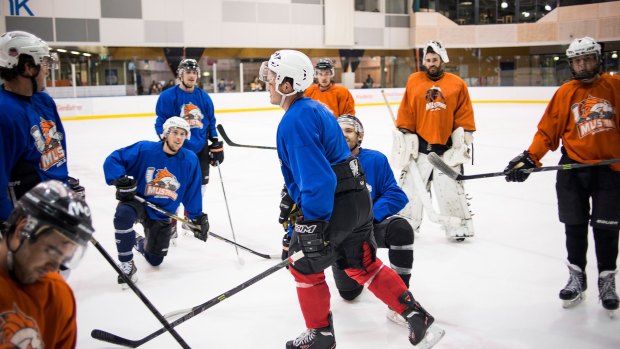By Chris Johnston
I'm watching Melbourne's champion ice hockey team, the Mustangs, at training. It's bedlam. The black rubber pucks fly around like artillery. The players, especially the goaltenders, are armoured as if for medieval battle. The skills and speed and the crunching hip-and-shoulder bumps are amazing. The Mustangs have three pairs of brothers playing for them.
The team won both the final and the league in the highest Australian competition last year after forming only five years ago. They train at full pelt for an hour then exit the swank Icehouse rink at Docklands so their arch-rivals, Melbourne Ice, can begin.

So cool: Mustang Jamie Bourke skates away after a team meeting at The Icehouse.Credit: Josh Robenstone
It all feels like a hidden sporting world in Melbourne, the minnows within the domain of AFL, A-League, cricket and basketball. Football and cricket are birthright sports here; ice hockey is not. Not in the driest continent on earth where ice is scarce.
"There's a footy oval on every corner," says the Mustang's vice-president Andy McDowell, a mechanic. "Top ice hockey countries like Canada, Russia, Sweden, Finland – ice and ice rinks [are] everywhere over there."
The Australian Sports Commission classify it as an unfunded, minority sport on a par with darts, lacrosse, ice skating and synchronised swimming in terms of profile and popularity. Ice hockey, nationally, it says, has 4000 members, athletes, coaches and officials. The Mustangs hope for about 200 members this season, which begins at Easter.
Yet – and this is one of those "who knew?" facts – ice hockey started in Melbourne in 1906. This was at a place called the Glaciarium, a huge, ornate rink in City Road, Southbank. It was the third-largest ice rink in the world and was built by refrigeration pioneer Henry Reid. The first known competitive game in Australia was played there between a Victorian team and some visiting American sailors.
According to Melbourne architect Ross Carpenter's website Ice Legends Australia - www.icelegendsaustralia.com - two years later a local league began with four teams: the Beavers, Brighton, Glaciarium and Melbourne. The two strongest grassroots clubs now – the Melbourne Demons and the Dandenong Blackhawks – both formed in the 1940s. Trucking magnate Lindsay Fox played for the Demons.
McDowell says when he started playing in the 1970s there were rinks in St Kilda, Ringwood, Footscray, Oakleigh and Ballarat. Now there are two – the Icehouse and the fading old rink in Oakleigh. A flash new rink is about to be built in Pakenham.
"On Saturday nights at Iceland in Ringwood on the Maroondah Highway I saw AC/DC, Ol '55 and Skyhooks," he says. "The night AC/DC played, with Bon Scott, the ice cracked."
Rinks survive on "general sessions" for the public to ice skate but sports clubs also use the facilities because there is nowhere else to go. Unlike football, basketball or cricket, ice hockey cannot be played just anywhere.
But the sport dreams big. Especially down at the Mustangs, who after starting from nothing in 2010 and wooden-spooned the league in 2012 came good to win it against highly fancied opposition last season. Says star player Jamie Bourke, 27, who has also played for Australia: "We are now the team to beat."
Club president John Belic says ice hockey is a better spectator sport than basketball. "Without creating a war with basketball," he says, "but it just is." He says the "sanitisation" of AFL was drawing fans away from footy, but while punching and fighting was essentially sanctioned in North American ice hockey with only a five-minute sin-bin, in Australia a fight or punch meant several weeks out.
"In this country it is a mums-and-dads-and-kids sport," he says. "Fights don't encourage grass-roots development. But there is no shortage of hits and bumps."
One of the main tactics in ice hockey – like Australian football – is giving an opponent less time on the puck [or ball], so intimidation plays a large part.
Bourke was described to me this week as "the Gary Ablett of ice hockey". His skills and instinct for the game are prodigious. Yet he personifies the amateur status of the sport – he has been picked for Australia again, for a tournament in Iceland next month – but can't go because he can't take enough time off at work. He works in the demolition industry.
Ice hockey's national competition - the AIHL - has eight teams; two in Melbourne, two in Sydney and one each in Perth, Newcastle, Adelaide and Canberra. Last year the Canberra team folded but fans helped raised money and started a new one. A Gold Coast team is in hiatus because it does not have a rink.
The Mustangs players are not paid but the club provides their gear, interstate travel and accommodation, which is not in hotels but cabin parks. About 30 travelling fans go with the team, staying in the same cabin parks. Players in both Sydney teams pay a fee to play.
The overseas players, from countries where instead of playing kick-to-kick on the street you play ice hockey on a frozen pond, are helped with travel, accommodation, a car and, sometimes, employment. Clubs are allowed six on their list and four on the rink at one time.
Belic says the Mustangs' biggest dream is to use no imports and develop an all-local champion team. "We have sworn that this is our number one dream. We are a long way off yet, but we honestly believe we can do it."